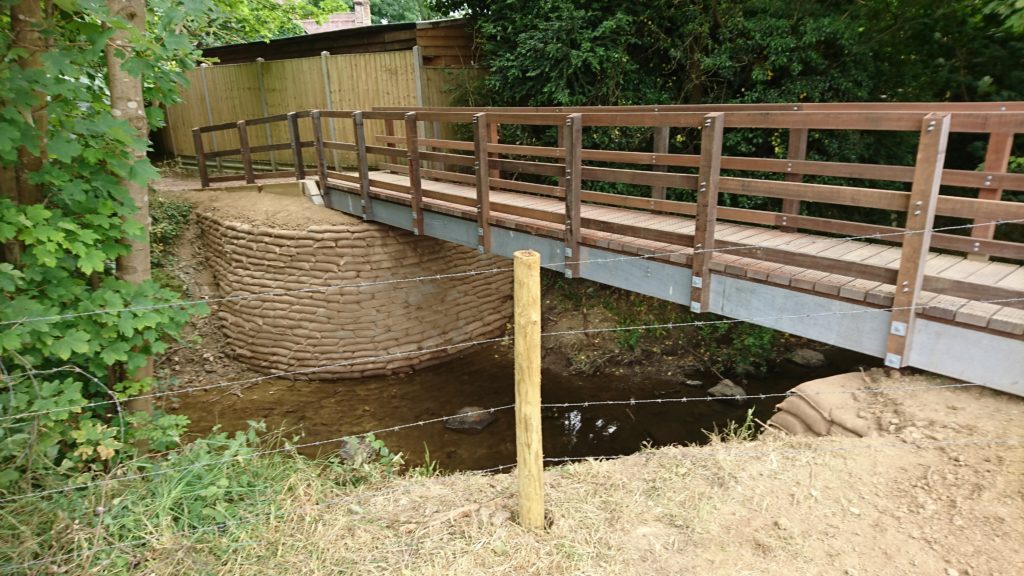Concrete Filled Bagwork
Simple, Clean & Environmentally Acceptable
SoluForm Concrete Filled Bagwork
SoluForm concrete filled bagwork is available pre-filled and arrives ready to use.

 We currently offer a 32N high strength structural mix within our bagwork products.
We currently offer a 32N high strength structural mix within our bagwork products.
The high strength structural mix is designed to form a longer lasting, durable concrete block, suitable for a range of underpinning, scour protection and river walling projects, and works particularly well with steelwork. This structural mix is typically used for schemes specified by Consultants, for more technically demanding schemes, or where there is a need for a longer design life. The high strength mix is available in both the underwater and above water bag options.

Underwater Bagwork Product Datasheet
Prefilled SoluForm Underwater Bagwork is designed for the hand placement of concrete in watercourses.

Above Water Bagwork Product Datasheet
Prefilled SoluForm Above Water Bagwork is designed for the hand placement of concrete, above the waterline or away from watercourses.
Patented Biodegradable Liners
Underwater bagwork utilises SoluForm’s patented biodegradable liners and enable dry mix concrete to be placed below water, with the use of steelwork, in a clean and environmentally acceptable manner. Alternatively, our water soluble above water bagwork can be useful for dry or out-of-water bagwork applications, or for schemes where either the environmental risk isn’t there, or the risk can be managed. In the absence of surrounding water, above water bagwork is hydrated by either pre-soaking or hosing in situ, dependant upon where the bagwork is placed.
The important considerations when selecting the type of concrete are Function and Design Life. The temptation is always there to put in a low strength, low durability, cheaper concrete mix but the consequence is ultimately a poorly performing bagwork construction with a short design life.
For high value or vulnerable assets, we recommend always repairing and protecting with structural grade concretes.
Steelwork
Steelwork should be included to tie the individual blocks together, helping to create a large singular block of concrete bagwork. Steelwork is important in schemes where protection against scour is needed, or the design life of the blockwork needs extending, to prevent individual blocks from being dislodged.
Steel rebar pins are pushed down through the bags during placement, and can also be used to tie blockwork to other structures, like abutments or retaining walls.
We stock standard sized 300mm long, U shaped, galvanised mild steel rebar pins that are suitable for use with our bagwork. Other thicknesses, sizes and grades of steel can be provided on request, given sufficient lead time.



-
Simple to use. No specialist skills required.
-
Can be carried and placed by hand.
-
A very cost effective means of placing concrete underwater or near a watercourse, in a safe and environmentally acceptable manner.
-
Allow placement of concrete in most cases without the need for dewatering or temporary works.
-
Liners either biodegrade along with the hessian outer bags or dissolve, to leave just the concrete block. No waste is therefore placed in the watercourse.
-
Our underwater liners and hessian outer bags are manufactured from natural, renewable and sustainable resources.
-
Unlike grout bags, no specialist plant or pumps are required to fill or place the bagwork.
-
Several design mix options available.
-
Allows dry mixes to be placed both above and below water.
-
Unlike grout pumping, no mixing or pumping of material within the river takes place, so placement is inherently safer for the watercourse.
-
A highly adaptable system – allowing site personnel the ability to adapt to changes in design, install a solution despite limited information of the problem, or work around unforeseen obstacles.
-
The bagwork product is available “off the shelf” and often available within a few days of ordering.
-
Concrete bagwork is fully carbon neutral
-
EPD (Environmental Product Declaration) Certified by BRE
Design Guidance*
We have a number of standard concrete bagwork wall designs for both in-water and non river applications. These are backed up with design calculations, risk assessments and design check statements and can be supplied upon request.
Non River Designs
In River Designs
Design guidance documents are in Acrobat PDF format. If you wish to save these to your local computer, please right-click each link and select the ‘Save As’ option.
* Site specific conditions (such as presence of water, slope stability, soil bearing capacity etc.) should be considered by a qualified and experienced civil or structural engineer.
Assembly Instructions / How to Use SoluForm Concrete Bagwork
All prefilled bagwork should remain palletised and wrapped until ready to use. Palletised bagwork should be stored in the dry, or suitably covered and protected if stored outside.
Care should be taken in removing protective wrapping, so as not to cut or damage the bagwork. Likewise, the bags should be inspected before placement for obvious signs of damage.
When ready to use, bagwork should be removed individually from the pallet wrapping, and individual bags gently shaken, rolled or squeezed to loosen any compacted dry mix concrete contained within each bag. Should there be any small amounts of cement powder on the outside of the bag, resulting from the filling process, this can be gently brushed off with a soft brush, prior to approaching the watercourse.
Where bags are more heavily dusty, it is likely that the liner has ruptured during transit and the bags should not be used. Only intact, undamaged bags should be carried into or used in the watercourse.
Where damage has occurred during transit, these damaged bags should not generally be used, although often the dry mix can be reused to refill empty bagwork or reutilised for other purposes. We would also recommend periodic inspections are carried out to check for any damage from other factors such as adverse weather conditions, vandalism, contamination, etc.
Prefilled Underwater Bagwork relies upon the surrounding water to hydrate the concrete. For this to occur, steelwork is needed; the steelwork piercing each and every bag creating a pathway for the surrounding water to enter the bag and disperse around the concrete. When submerged underwater, and with a single standard pin through each bag, hydration and hardening typically takes around 6-12 hours, such that bagwork will have fully hardened by the next working day. Full strength is achieved within 28 days.
The procedure for placement below water level is:
- Unopened, loosened pre-filled underwater bagwork should be carefully carried, individually and by hand, through the watercourse to the location where they are needed. Each bag should be carefully placed horizontally, taking care not to drop, snag or tear the bags on sharp objects. Bagwork is to be placed flat and built up in rows, typically alternating or cross bonding bagwork to improve the strength of the finished blockwork. Bagwork can be patted flat or shaped once placed, to improve the appearance of the bagwork and reduce the amount of voids within the finished blockwork. Patting or shaping must be completed before the bagwork is pierced with steelwork.
- Underwater bagwork placed by divers can also be lowered into the river in 1T bulk bags. The divers can then remove individual prefilled bags from the bulk bag, by hand, to be carried and placed by the divers.
- After the second or third row of bags, steel rebar pins should be used to provide a pathway for water to enter the bag and hydrate the concrete, and to tie all the finished blockwork together. Pins can be inserted by hand, or if a hammer is used, this should be a rubber mallet. Steelwork pins should be pushed down vertically through the bags, with steelwork passing through each and every bag. Once placed and stacked, the tight seal between the steelwork and the liners, the tight packing between the individual bags and the fact that the steelwork is inserted vertically through the bags, ensures there is no loss of cement fines from the bags during placement or from piercing the bags.
- Further rows of bagwork and steelwork can be added, to take the wall or bagwork up to the required height. Typically standard 300mm long steelwork pins are inserted every two rows of bagwork, piercing 3 rows of bagwork with a single 300mm long pin. Ensure all the bagwork is pierced with at least one rebar pin, creating up to four entry points for each bag.
- Once pierced, air bubbles will typically escape from each bag, as water enters the bagwork and displaces any trapped air.
In situations where water levels can be manipulated or is expected to rise and submerge the bagwork for a 12hr period following placement of the bagwork, it can also be possible to utilise Underwater Bagwork for higher level works. In all instances however, dry bagwork should not be left on site without either being wetted or anticipated to be fully hydrated within the following 24hr period.
Prefilled bagwork placed away from any watercourse needs to be hydrated prior to or during placement. This can either be achieved by pre-soaking the lined bagwork in a bath of water for approximately 15 minutes prior to placement, or by thoroughly wetting the bagwork during placement (typically for a minimum of 3 minutes). The water soluble liner will begin to dissolve in 5 seconds and is typically fully dissolved within approximately 15 seconds, sufficient enough to allow water to readily soak into the dry mix to harden the concrete. Typically a 20kg bag will absorb around 4L of water during this process so it is important to have a ready supply of water available and to top up at regular intervals.
When ready to use, each of the bags should be removed from the pallet and if pre-soaked, fully submerged in a suitable bath of water. Once hydrated (approximately 15 minutes), the bagwork can be carefully lifted from the bath and excess water allowed to drain. The pre-soaked bagwork should be carried, individually by hand or using a wheel barrow, to the site of placement.
Each bag should be carefully placed horizontally, taking care not to drop, snag or tear the bags on sharp objects. Bagwork is to be placed flat and built up in rows, typically alternating or cross bonding bagwork. Cross bonding improves the strength and effectiveness of the finished concrete blockwork. Bagwork can be patted flat or shaped once placed, to improve the appearance of the bagwork and reduce the amount of voids within the finished blockwork.
After the second or third row of bags, steel rebar pins can be pushed down vertically through the bagwork to tie all the blockwork together, with additional steel used to tie subsequent rows. Pins can be inserted by hand, or if a hammer is used, this should be a rubber mallet. Steelwork is not always needed for above water bagwork although we do recommend that it is used wherever the bags are needed for medium to long term works, or where additional wall strength is needed. Typically standard 300mm long steelwork pins are inserted every two rows of bagwork, piercing 3 rows of bagwork with a single 300mm long pin.
Should the bagwork be placed dry with the intention of hosing the bagwork in situ, we recommend that each row is placed and wetted in situ individually, wetted for at least 3 minutes to ensure adequate take up of water to achieve full hydration and strength.
Upon completion of the works, if used, the temporary bath of water should be emptied and disposed of in a safe and environmentally acceptable manner. Bear in mind that the water will be of high pH, may be sediment laden and will contain dissolved liner material. This water should therefore not be discharged into any watercourse.
We would also recommend periodic inspections are carried out to check for any damage from other factors such as adverse weather conditions, vandalism, contamination, etc.
The main difference between bagwork placed above a watercourse and bagwork placed away from a watercourse is that typically bagwork cannot be hosed down during placement and will need to be pre-soaked. This is to avoid the potential for water flushing off the bagwork and directly entering the watercourse. Where the watercourse has been dewatered for the construction works, hosing concrete bagwork can sometimes be undertaken although this is usually subject to regulatory consent and a suitable and approved method statement. In those instances, care and consideration should be made to the potential risk and consequences of any flushings then entering the watercourse.
For above water placement, similarly prefilled bagwork supplied as a dry mix needs to be hydrated prior to placement. This should typically be achieved by pre-soaking the lined bagwork in a bath of water for approximately 15 minutes prior to placement. The water soluble liner will begin to dissolve in 5 seconds and is typically fully dissolved within approximately 15 seconds, sufficient enough to allow water to readily soak into the dry mix to harden the concrete. Typically a 20kg bag will absorb around 4L of water during this process so it is important to have a ready supply of water available and to top up at regular intervals.
When ready to use, each of the bags should be removed from the pallet and fully submerged in a suitable bath of water. Once hydrated, the bagwork can be carefully lifted from the bath and excess water allowed to drain. The pre-soaked bagwork should be carried, individually by hand or using a wheel barrow, to the site of placement. The worksite should be approached from the dry side, such that pre-soaked bagwork is not carried over or through the watercourse unnecessarily, where slips, trips or falls could result in the bagwork being dropped into the water. The Contractor’s method statement should include measures to ensure that pre-soaked bagwork is not carried through a watercourse, unavoidably.
Each bag should be carefully placed horizontally, taking care not to drop, snag or tear the bags on sharp objects. Bagwork is to be placed flat and built up in rows, typically alternating or cross bonding bagwork. Cross bonding improves the strength and effectiveness of the finished concrete blockwork. Bagwork can be patted flat or shaped once placed, to improve the appearance of the bagwork and reduce the amount of voids within the finished blockwork.
After the second or third row of bags, steel rebar pins can be pushed down vertically through the bagwork to tie all the blockwork together, with additional steel used to tie subsequent rows. Pins can be inserted by hand, or if a hammer is used, this should be a rubber mallet. Steelwork is not always needed for above water bagwork although we do recommend that it is used wherever the bags are needed for medium to long term works, or where they fulfil a role of providing protection against scour. It also protects against vandalism, or blocks becoming dislodged during flood conditions. Typically standard 300mm long steelwork pins are inserted every two rows of bagwork, piercing 3 rows of bagwork with a single 300mm long pin.
Due to the risk of uncontrolled flushings entering the watercourse, we do not generally recommend wetting insitu for over water works, however in controlled situations this may still be possible. The use of non pre-soaked water soluble bagwork in above water applications should only be considered following an assessment of environmental risk and regulatory approval. Should the bagwork be placed dry with the intention of hosing the bagwork in situ, we recommend that each row is placed and wetted in situ individually, wetted for at least 3 minutes to ensure adequate take up of water to achieve full hydration and strength.
Upon completion of the works, the temporary bath of water should be emptied and disposed of in a safe and environmentally acceptable manner. Bear in mind that the water will be of high pH, may be sediment laden and will contain dissolved liner material. This water should therefore not be discharged into any watercourse. We would also recommend periodic inspections are carried out to check for any damage from other factors such as adverse weather conditions, vandalism, contamination, etc.







